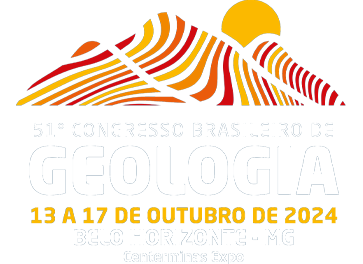Dados da Submissão
Título
DIAMOND SATELLITES IN ALLUVIAL CONCENTRATES: A CASE STUDY OF GORCEIXITE FROM WEST MINAS GERAIS STATE, BRAZIL
Texto do resumo
The Alto Paranaiba region (AP) in West MG is called “land of giant diamonds”, since all Brazilian gem diamonds over 300 carats came from here. Most gems have been washed from river gravels, only a few from Upper Cretaceous pyro-epiclastic rocks. Gorceixite (“Marumbé”), an abundant, aluminum phosphate with ideal chemical formula BaAl3PO4(PO3OH)OH6, was found as satellite in all diamondiferous gravels. The authors analyzed Gorceixite from localities south of Coromandel, from Rio Douradinhos diamondiferous gravels, as well as from Chapada dos Lemes. A few represent rhizoconcretions. The identification of these was done using a combination of powder X-ray diffraction (XRD), X-ray energy dispersive spectroscopy (EDS), scanning electron microscopy (SEM) and petrographical thin sections.
These gorceixites are microcrystalline aggregates of secondary origin and occur in cavities of several minerals together with other “favas” (a term used by garimpeiros for phosphates in such concentrates). The source of elements like Ba, and those of other “favas” with Sr and REE e.g. Ce is not discussed in references, or just mentioned as “unknown”. Intergranular micropores may result in a significant preservation of the REE content, and poorly crystallized and flaky secondary minerals act as traps for REE. Our radiometric measurements with a hand scintillometer revealed high backgrounds on the peneplains (chapadas) and their slopes, up to 400 CPS, in accordance with reginal geophysical maps e.g. ternary diagrams of K/Th/U. The authors suggest a different source for the AP diamonds which could point towards the presence of Gorceixite in all diamondiferous gravels. The Serra Negra–Salitre alkaline carbonatitic complex (SNSC) with a surface diameter of over 10 km and roots 60 km deep was a super-volcano during the Upper Cretaceous. Profiles across thick pyro-epiclastic rocks show several tuff levels and indicate that the SNSC was active during several million years.
These tuffs have a wide distribution in West MG and vicinities and point towards a huge scattered quantity of pyroclastics containing high amounts of elements like Ba, Sr and REE. Some eruptions brought diamonds to the surface, as proved by descriptions and analyses of these in the lower part of the pyro-epiclastics. Middle to late Tertiary dynamics, under specific climatic and environmental conditions have been responsible for the formation of chapadas. The oncoming weathering and erosional cycles dissolved and later concentrated elements like Ba, Sr, and REE under different environment conditions, which are found today also in river gravels as secondary phopsphate aggregates, together with diamonds.
Gorceixcite together with other “favas” occur also in many diamondiferous gravels outside the AP e.g. Diamantina (MG), Franca (SP), São José River near Paraguaçú (BA), Paranaíba and Veríssimo rivers (GO). Since the source for the elements in such “favas” is not known they could represent the consequence (secondary products) of the SNSC mega explosion, which have been extruded high into the stratosphere/mesosphere and scattered also over regions outside the AP, and may represent there a secondary, minor contribution of diamond exploration.
Palavras Chave
Satélites de diamantes; Gorceixita; Fonte
Área
TEMA 14 - Agrominerais, Rochagem, Rochas Ornamentais e Gemologia
Autores/Proponentes
Joachim Karfunkel, Donald Brunton Hoover , Herbert Poellmann, Friedrich Evald Renger, Ricardo Scholz, Klaus Krambrock, Luiz Carlos Borges Ribeiro, Mathew Forir, Gary Michelfelder, Carolina Campos Fereira Klock
